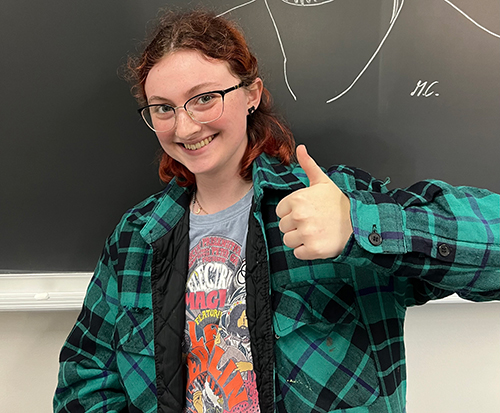Milo Eckhardt remembers well the fifth-grade research project that started it all.
As part of her class science unit on outer space, her teacher assigned her to gather information on the Voyager program that set out to explore Jupiter and Saturn in 1977. Voyager 1 and 2 then continued to Uranus and Neptune, and nearly 50 years later they’re still relaying insights into the outermost reaches of the solar system.

Milo Eckhardt, a junior studying physics with a concentration in astrophysics, signed up as an “eclipse ambassador” through a new NASA-funded program run through the Astronomical Society of the Pacific.
“That was the best thing that could have happened to me,” said Eckhardt, now a junior studying physics with a concentration in astrophysics and a minor in mathematics at The University of Toledo. “I have not been able to stop thinking about space since fifth grade.”
Eckhardt isn’t one to keep her excitement to herself. As a part-time technician at the Ritter Planetarium, her favorite days are when a member of the audience finds her after a presentation to ask a few more questions about what she’s just shared.
So it seemed natural for her to sign up as an “eclipse ambassador” through a new NASA-funded program run through the Astronomical Society of the Pacific. The Eclipse Ambassadors Off the Path program pairs undergraduate students like herself with eclipse enthusiasts in their geographic communities to engage those who live off the path of totality. Ambassador teams are tasked with offering context, building excitement and promoting safety by distributing free solar viewing classes — work that’s gearing up ahead of the total solar eclipse that’s set to cross the contiguous United States on Monday, April 8.
“I would love to share that experience that I had in the fifth grade with other kids or even adults, to recreate that magic of first finding out about space,” Eckhardt said.
A solar eclipse occurs when the moon passes between the sun and the Earth, casting an all-encompassing shadow along what’s known as the path of totality. It’s a rare viewing opportunity that won’t repeat in the United States until 2044.
Toledo falls along the path of totality on April 8. But Westerville, Ohio, where Eckhardt grew up, is not so lucky. That qualifies Westerville as “off the path,” and ripe for the sort of outreach that Eckhardt and her program partner, a middle-school teacher in nearby Cardington, Ohio, have been planning at Cardington-Lincoln Middle School and through the Girl Scouts of Ohio’s Heartland.
They’re sharing their insights, enthusiasm and glasses in several online and in-person events through March. Their first was in mid-February.
“As someone who regularly educates audiences about astronomy in the Ritter Planetarium, Milo is an ideal person to help the public learn about the upcoming eclipse,” said Michael Cushing, a professor in the Department of Physics and Astronomy and director of the Ritter Planetarium.
Westerville and Cardington offer a different audience than northwest Ohio, where eclipse education and enthusiasm have been building up for months. Without the promise of totality in their target communities, eclipse ambassadors have to be more deliberate in their outreach efforts.
Eclipse Ambassadors Off the Path asks each set of partners to reach 200-plus people with their self-directed outreach activities, with at least half of those from underserved communities. The program, which accepted applicants through mid-February, aimed to facilitate at least 500 partnerships.
All outreach needs to be completed by April 8, freeing ambassadors and those they’ve reached to make their own plans to experience the eclipse. Eckhardt anticipates being on campus and participating in a community viewing event that will kick off by noon in Glass Bowl Stadium.
She’ll be looking up just before 3:15 p.m.
“I’ve never been able see an eclipse before, let alone one with full totality,” she said. “It’s very exciting.”